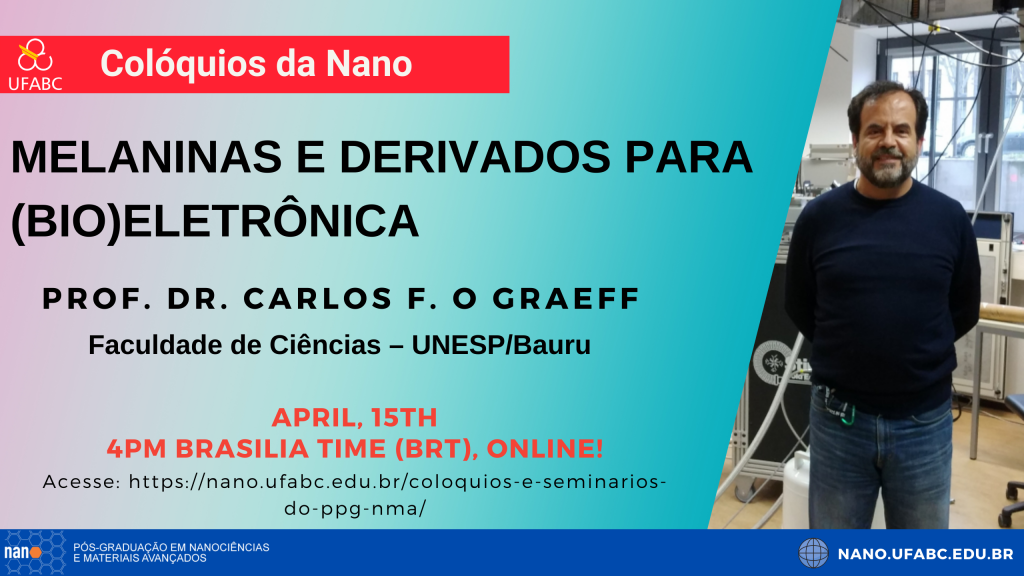
Palestrante: Prof. Carlos F. O Graeff (Faculdade de Ciências – UNESP/Bauru)
Título: Melaninas e derivados para (bio)eletrônica
Data: 15/04 às 16h Link: https://youtu.be/KvfrfK8RAm4
Resumo: Melaninas são uma importante classe de pigmentos naturais, normalmente associados a fotoproteção e ao câncer de pele melanoma. Como uma classe de materiais, as melaninas apresentam uma series de propriedades físico-químicas (absorbância óptica de banda larga, quelação de grande quantidade de íons de metálicos, presença de radical livre estável e condutividade dependente de hidratação com capacidade de sustentar uma corrente protônica de estado sólido) que tem potencial aplicação em uma grande quantidade de componentes eletrônicos como baterias e capacitores, diodos emissores de luz, dispositivos de memória, fotoeletrodos, células solares, transistores e sensores. Contudo, as melaninas apresentam duas grandes desvantagens em relação a outros (bio)materiais que são insolubilidade na maior parte dos solventes comumente utilizados e relativa boa aderência apenas em substratos hidrofílicos. Desta forma, em nosso grupo de pesquisa combinamos química orgânica e física da matéria condensada para desenvolver diferentes derivados de melanina e estudar suas propriedades físico-químicas. Os resultados obtidos sugerem que estes novos derivados de melanina são alternativas bastante atraentes para fabricação de dispositivos (bio)eletrônicos. Caso você faça parte do programa da pós entre em contato para participar da webconferência.
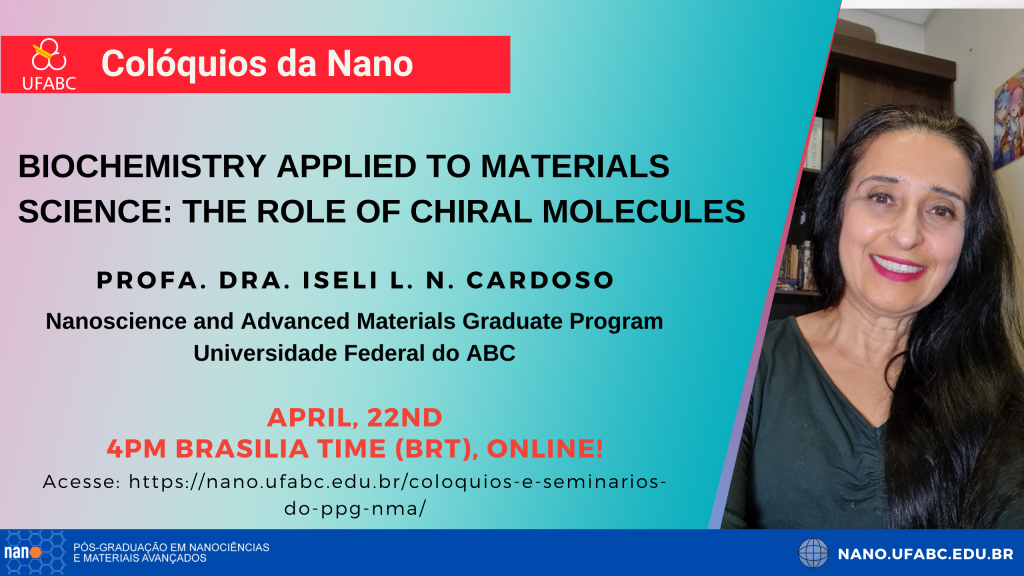
Palestrante: Prof. Iseli L. N. Cardoso (UFABC)
Título: Biochemistry Applied to Materials Science: The Role of Chiral Molecules
Data: 22/04 às 16h
Link: https://youtu.be/HwumQcVi-Es
Resumo: A molecular structure is said chiral when its mirror image does not overlap the original structure, and these structures are non-superimposable, just like our left and right hands. In 1848 Pasteur observed that crystallization of tartaric produced two different crystals with non‐superimposable mirror‐images and constituted by isomers that in solution exhibited optical rotations of equal magnitude but opposite in directions. From that time on, many advances occurred, but the studies and applications of chiral molecules were restricted to the fields of Chemistry and Biochemistry for a long time. Recently, chiral molecules have gained enormous importance for materials science due to the discovery of the Chiral Induced Spin Selectivity (CISS) effect. The CISS effect could relate the spin orientation to the molecular frame and superstructures such as the protein alpha-helix secondary structure. After charge polarization, chiral molecules and moieties have a preferred orientation of the electron spin in the molecular structure. Thus, the CISS effect allows the manipulation of chemical reactions and, more recently, has been used for enantiomer separations and biorecognition processes. The CISS effect results that electron transport is spin-selective through chiral molecules and can be applied to develop spintronic devices. Materials with spin selectivity have been obtained through the association with chiral molecules, the growing of crystal with chiral distortion induced by the template of biomolecules, and chiral molecules in the crystal structure as recently described perovskites. In our group, these strategies are being applied by the association of cytochrome c with hierarchically structured nanowires of iron oxides, production of optically active Co3O4 templated by ferritin and histidine, and the modification of perovskite by D and L-histidine.Caso você faça parte do programa da pós entre em contato para participar da webconferência.
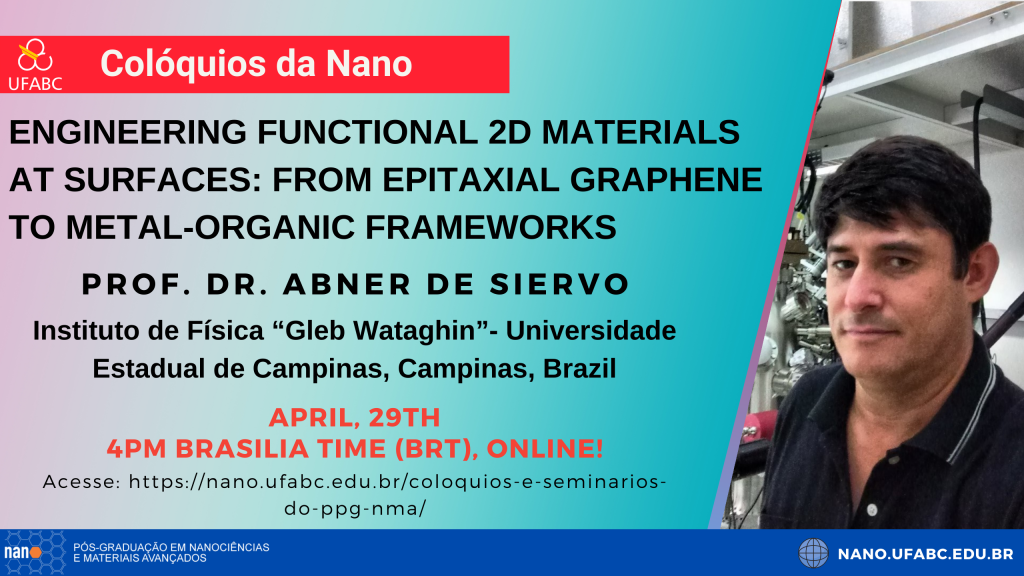
Palestrante: Prof. Dr. Abner de Siervo (IFGW-Unicamp)
Título: Engineering functional 2D materials at surfaces: from epitaxial graphene to metal-organic frameworks
Data: 29/04 às 16h Link: https://youtu.be/gFwIOkzcv_4
Resumo: The so-called 2D materials emerged in the last decades as an exciting new area for research that discovered new physics phenomena as well as plenty of room for technological applications. These materials can be divided into different classes that involve (1) one-atom-thick layer like the graphene “celebrity”, twisted graphene layers, and other members like h-BN, borophene, phosphorene, stanene, and so on; (2) layered materials like transition metal dichalcogenides (TMDs), and topological insulators; and (3) 2D functional organic-networks [1,2]. These materials have shown new interesting physical phenomena like linear-electronic dispersion, quantum-hall effect, outstanding photonic properties, unexpected magnetic, superconductor, ferroelectric, and piezoelectric behaviors [1,2]. All these physical phenomena have driven the community to propose applications for these materials in many different areas such as new supports for catalysts, supercapacitors, sensors, energy production (e.g solar cells) and storage, electronic and photonic devices, among others. Many of the interesting properties shown by 2D materials are attributed to the quantum confinement effects due to the reduced size in one dimension, i.e monolayer. Despite the wonderful possibilities, a bottleneck for applications with industrial-scale in some areas, for instance in the electronic industry, relies on a controllable way to produce large amounts of high-quality materials with specific characteristics, for instance, a large single-domain area of monolayer 2D material. Our group in Campinas has been working during the last years on the epitaxial growth of different members of these families (graphene, h-BN, h-BNC alloys, TMDs, and 2D-organic frameworks) [3-10] to better understand the electronic and atomic structure of these materials. In this seminar, I will show recent examples where we have applied different growth and functionalization strategies to produce epitaxial 2D materials. The electronic and atomic structure of these materials were characterized by combing different synchrotron-based techniques, such as x-ray photoemission and absorption spectroscopies with other surface science techniques, for instance, scanning tunneling microscopy and spectroscopy, as well as the support of theoretical calculations based on density-functional theory (DFT), to improve the understanding of the materials at an atomic scale. References: [1] Mengqi Zeng, et al. Chemical Reviews 118 (13), 6236-6296 (2018). [2] Akinwande, et al. Nature 573, 507–518 (2019). [3] L.H. de Lima et al., Physical Review B 87, 081403(R) (2013). [4] L.H. de Lima et al., Chemistry of Materials 26 (14), 4172-4177 (2014). [5] Rodrigo C.C. Ferreira et al., Chemistry of Materials 30 (20), 7201-7210 (2018). [6] M. Lepper et al., Angew. Chem. Int. Ed.. 57, 10074-10079 (2018). [7] Juan Carlos Moreno-López et al., Chemistry of Materials 31 (8), 3009-3017 (2019). [8] Alisson Ceccatto dos Santos, et al., Chemistry of Materials 32 (5), 2114-2122 (2020). [9] Gabriela Moura do Amaral, et al., Applied Surface Science, 538,148138 (2021). [10] Nataly Herrera-Reinoza, et al., Chemistry of Materials XX, xxxx-xxxx (2021). Caso você faça parte do programa da pós entre em contato para participar da webconferência.
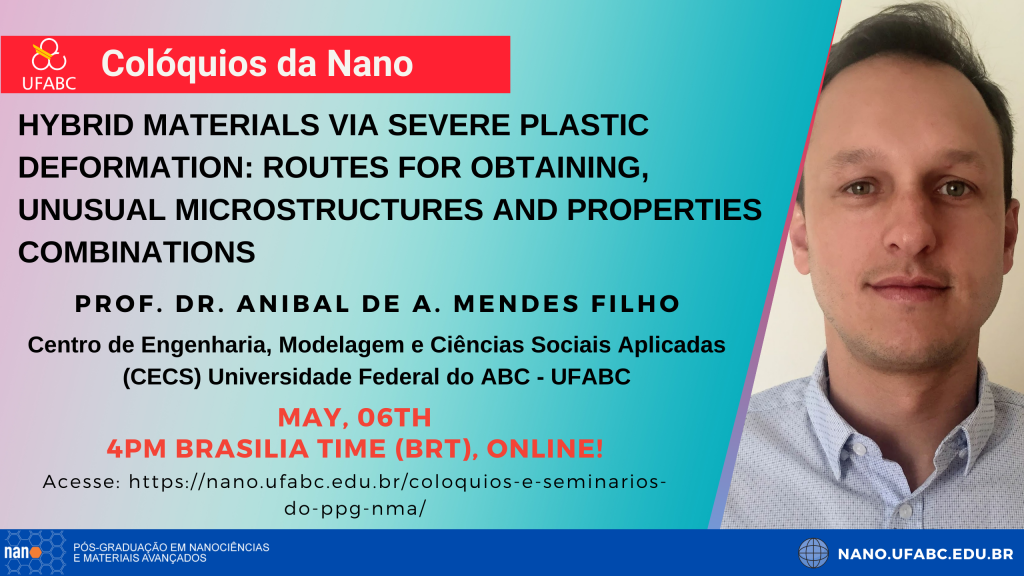
Palestrante: Prof. Dr. Anibal de A. Mendes Filho (CECS/UFABC)
Título: Hybrid materials via severe plastic deformation: routes for obtaining, unusual microstructures and properties combinations.
Data: 06/05 às 16h Link: https://youtu.be/utN9vD2QeQg
Resumo: A new important direction of research into severe plastic deformation (SPD) is the production of hybrid materials. Manufacturing hybrid materials with simultaneous nanostructuring by high shear strain processes is quite appealing, and the level of nanostructuring next to the interfaces within these composites is shown to be unreachable in single constituent materials. Recent results have shown a promising combination of typically concurrent properties in hybrid materials obtained via SPD routes. This talk will discuss some recent advances on the routes for obtaining these hybrid materials and its unusual microstructures and properties combinations. Caso você faça parte do programa da pós entre em contato para participar da webconferência.
RECESSO ACADÊMICO: 08 A 22 DE MAIO
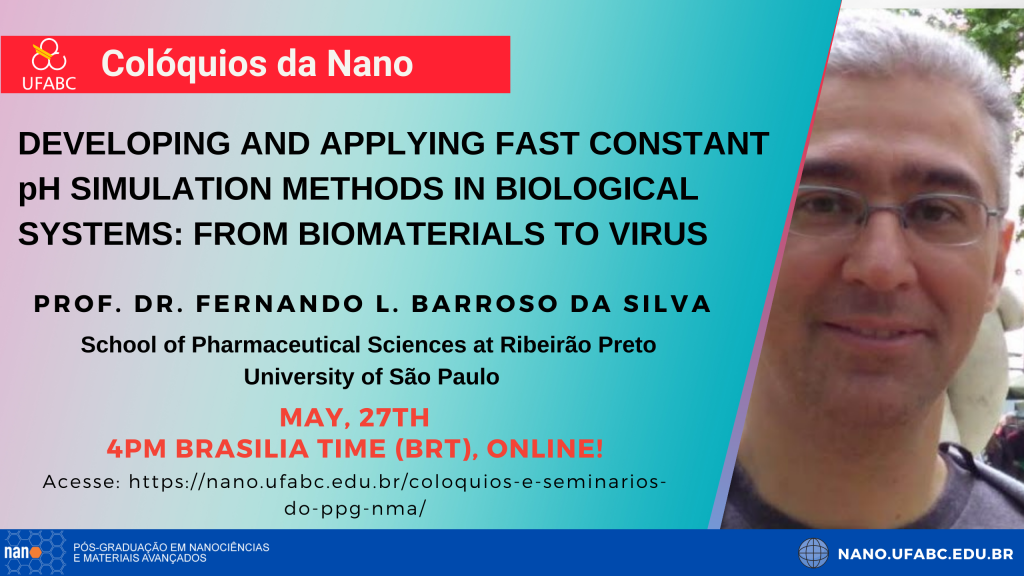
Palestrante: Prof. Fernando Luis Barroso da Silva (Department of Biomolecular Sciences School of Pharmaceutical Sciences at Ribeirão Preto – University of São Paulo)
Título: Developing and applying fast constant pH simulation methods in Biological systems: from biomaterials to virus
Data: 27/05 às 16h Link: https://youtu.be/rm9UFhHr0us
Resumo: pH is a key parameter for biological and technological processes. Its importance has been motivating the development of several theoretical methods to properly describe its effects. From quantum mechanical treatments to empirical descriptions, a diversity of methods is available in the literature. At our lab, our focus has been on the development of coarse-grained descriptions that could result in a good compromise between the proper modeling of the physics behind the systems and the simulation time. A fast proton titration scheme, rooted in the Kirkwood model of impenetrable spheres, where salt is treated at the Debye-Huckel level, was specially developed for both proteins and nucleic acids. It permits its application to much larger systems and a proper sampling of the complex electrostatic coupling between the ionizable sites and other charges and also opens up opportunities for the study of multibiomolecular systems. The latter is a real achievement for the simulation of such systems. pKa benchmarks and examples of its applicationsto study biomolecular interactions will be presented. Spidroins homoassociation, a possible molecular mechanism for the increase of the Zika virus virulence for the Brazilian strain and the optimization of therapeutic binders against SARS-COV-2 will be discussed. In this talk, I will also present a new developed scheme for fast constant-pH molecular dynamics studies. Caso você faça parte do programa da pós entre em contato para participar da webconferência.
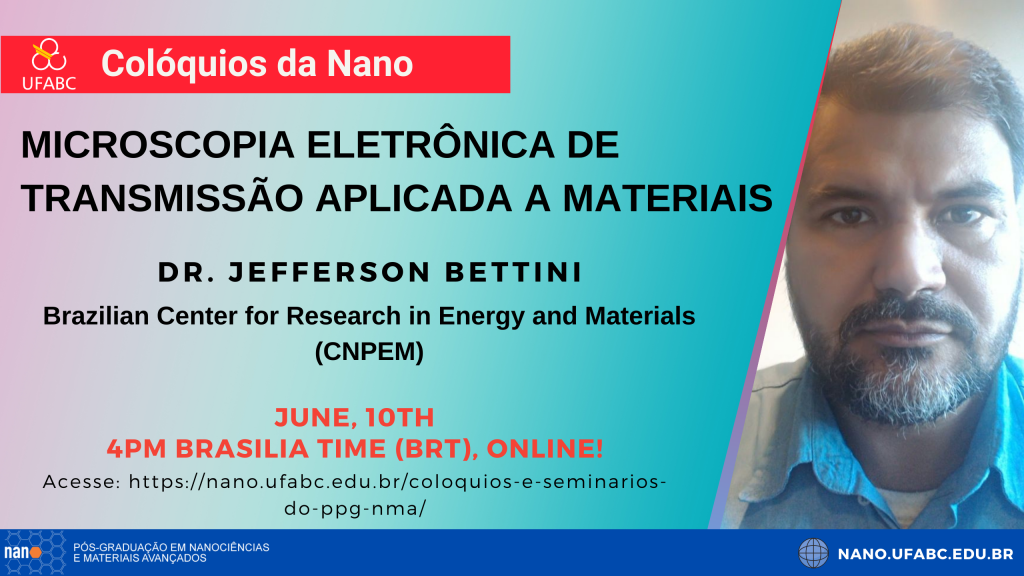
Palestrante: Dr. Jefferson Bettini ( Brazilian Center for Research in Energy and Materials – CNPEM)
Título: Microscopia Eletrônica de Transmissão aplicada a Materiais
Data: 10/06 às 16h Link: https://youtu.be/p1UmJ3YDGIo
Resumo: A Microscopia Eletrônica de Transmissão (MET) tem a capacidade de estudar e analisar materiais em diferentes escalas, desde a escala micrométrica até atômica. Através de Imagens, difração e espectroscopia obtidas por MET podemos obter diferentes informações como tamanho, forma, facetas, interfaces, defeitos, estrutura cristalina, orientação cristalográfica, tamanho da coerência estrutural, composição e estados de oxidação. Desta forma, mostraremos exemplos de analises em diferentes materiais para evidenciar que MET é uma ferramenta poderosa para o estudo e a pesquisa de materiais em nanociência e nanotecnologia.
Baixe a Carta de comparecimento
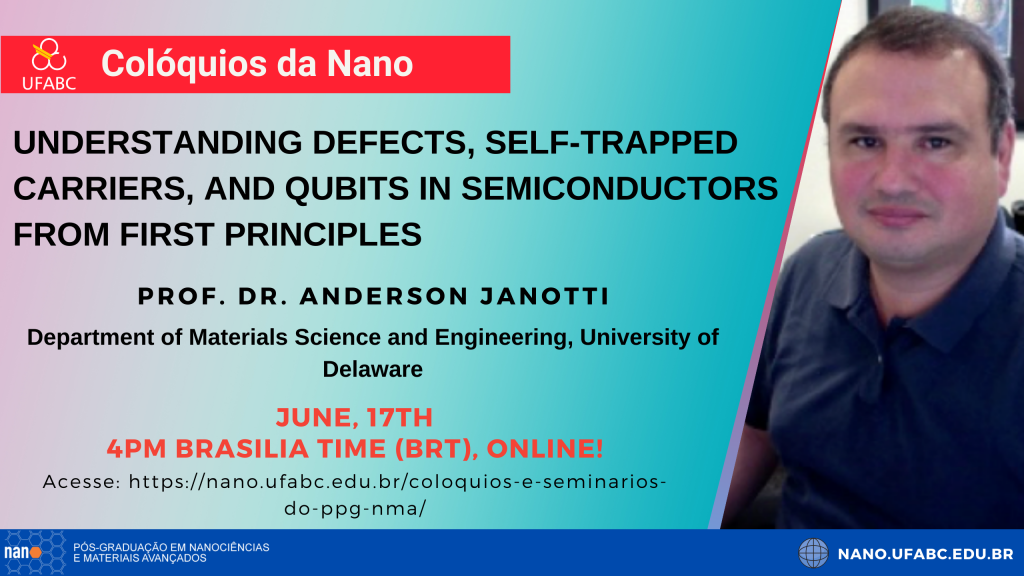
Palestrante: Prof. Dr. Anderson Janotti (Department of Materials Science and Engineering, University of Delaware)
Título: Understanding defects, self-trapped carriers, and qubits in semiconductors from first principles
Data: 17/06 às 16h Link: https://youtu.be/NJh8NFI6H_A
Resumo: First-principles calculations based on the density functional theory have emerged as a powerful tool to study defects in crystals. Besides serving as a guide in the interpretation of experimental results of materials characterization, these first-principles calculations can be used to predict novel properties and to provide information that are difficult to access experimentally. Recent developments in hybrid functionals and advanced in supercomputer power have led to unprecedented accuracy in the description of point defects in semiconductors and insulators, and their impact on materials properties. In this presentation we describe how first principles calculations are used to explore the impact of point defects on the electronic and optical of semiconductors, doping bottlenecks, the physics of small polarons, and the design on qubits for quantum computation. Caso você faça parte do programa da pós entre em contato para participar da webconferência.
Baixe a Carta de Comparecimento
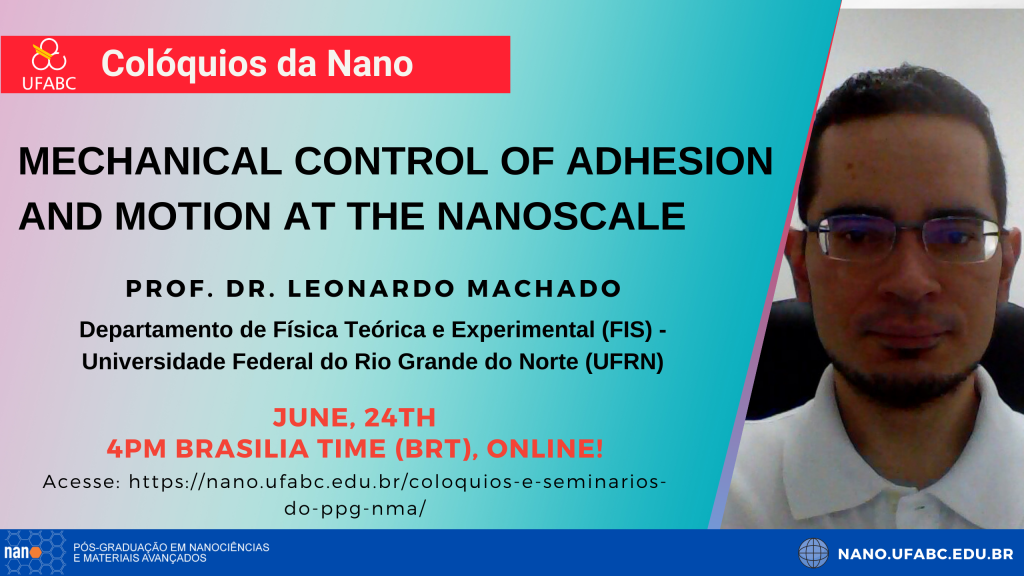
Palestrante: Prof. Leonardo Machado (Departamento de Física Teórica e Experimental – FIS – Universidade Federal do Rio Grande do Norte – UFRN)
Título: Mechanical control of adhesion and motion at the nanoscale
Data: 24/06 às 16h Link: https://youtu.be/ngM8Qvd7ITM
Resumo: Over the last three decades, carbon nanostructures have been intensively researched. Due to these investigations, materials with extraordinary mechanical, electronic, and thermal properties have been discovered. Examples include fullerenes, carbon nanotubes, and graphene. In this seminar, the main topic of discussion will be the mechanical properties of carbon nanomaterials. However, the focus will not be on the search for stronger materials, but rather on the investigations to control other properties through mechanical stimuli. In the first half of this seminar, we will briefly discuss how electronic and thermal properties change in two-dimensional (2D) materials with the application of strain. Then, I will present results that detail how to use strain to control adhesion in a 2D covalent organic framework, as well as a possible application of this effect. In the second half of this seminar, the topic will be the use of mechanical stimuli to displace nanostructures in a direction of interest. We will discuss why it is so difficult to control motion at the nanoscale, and proposals that attempt to solve this problem. Finally, I will present recent results that show how curved nanostructures can be used to direct motion at the nanoscale. Caso você faça parte do programa da pós entre em contato para participar da webconferência.
Carta de comparecimento: Baixe aqui
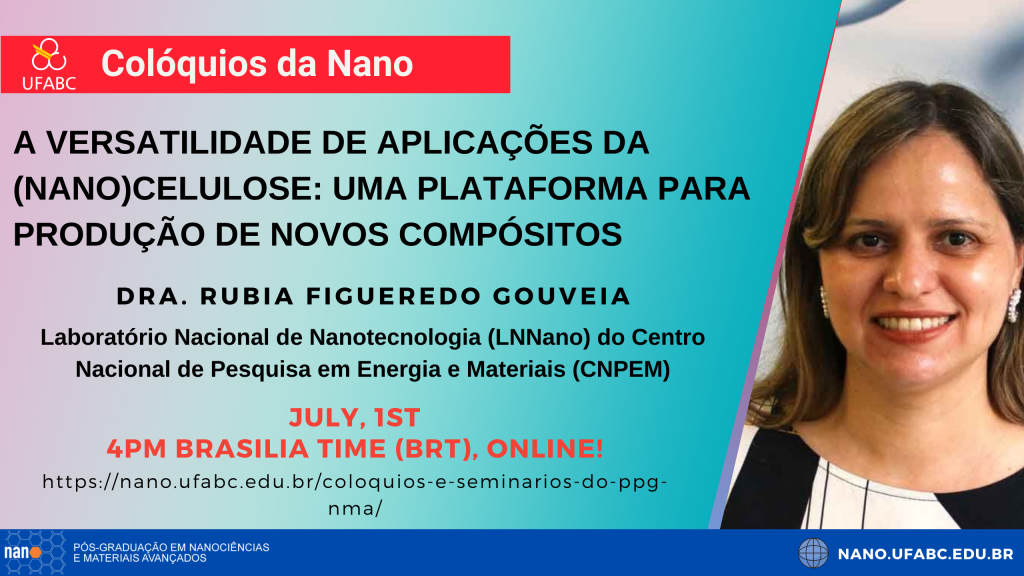
Palestrante: Dra. Rubia Figueredo Gouveia (LNNano/CNPEM)
Título: A versatilidade de aplicações da (nano)celulose: uma plataforma para produção de novos compósitos
Data: 01/07 às 16h Link: https://youtu.be/B0oW0VO3Y1E – a pedido não haverá disponibilização deste colóquio via Youtube para assistir posteriormente. Acesse Zoom a atividade pelo Zoom: https://us02web.zoom.us/j/88309418568?pwd=VWxqZHpGK1kzdHhhUGl2aE9OcElYQT09
Resumo: A produção de novos materiais a partir de fontes abundantes, como a biomassa, é muito atrativa, dadas as suas características intrínsecas que possibilitam a transformações em novos materiais. Desta forma, pesquisas compreendidas no uso da biomassa para a geração de novos produtos são estratégicas para o desenvolvimento econômico do país, uma vez que esses subprodutos são regularmente produzidos no Brasil. Logo, o resultado de pesquisas neste tema pode gerar novos materiais economicamente viáveis com características diferenciadas e competitivas, além de agregar um caráter sustentável. Neste seminário será abordado a aplicação da (nano)celulose, uma matéria-prima versátil para a produção de compósitos poliméricos. Esses novos materiais renováveis são utilizados em diferentes aplicações, como adesivos, adsorventes de poluentes ambientais, materiais para engenharia e regeneração óssea. Caso você faça parte do programa da pós entre em contato para participar da webconferência.
Carta de comparecimento
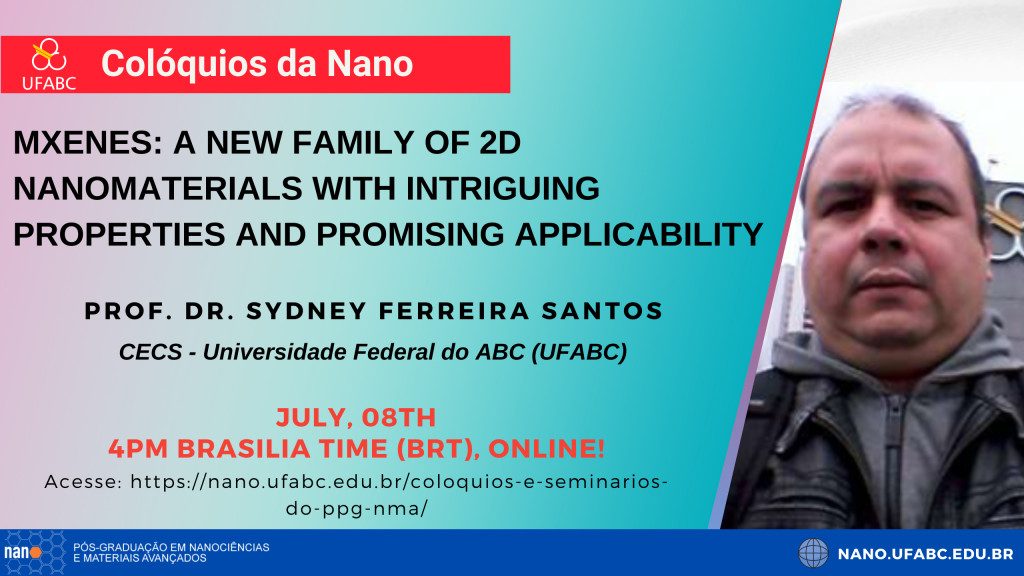
Palestrante: Prof. Dr. Sydney Ferreira dos Santos (CECS/UFABC)
Título: MXenes: a new family of 2D nanomaterials with intriguing properties and promising applicability
Data: 08/07 às 16h Link: https://youtu.be/tSBnzZr_ynQ
Resumo: MXenes is a new family 2D inorganic compounds comprising transition metal carbides and nitrides. The research activity on these compounds has growing quickly motivated by their unique properties derived from complex bonding (a mixture of metallic and covalent bonds), electronic structures, atomic stacking, synthesis routes, variety of chemical composition and microstructues, and surface chemistry. All these features affect the compounds’ properties and applicability of these materials in commercial products. In this lecture, we will overview the main aspects of these materials, properties of interest and potential technological applications with main focus on structural materials and energy. Moreover, strategies to tune properties targeting product developments are also discussed. Some cases of structural and functional applications will be highlighted based in results from the literature and from our research group. Caso você faça parte do programa da pós entre em contato para participar da webconferência.
Carta de comparecimento:Baixe aqui
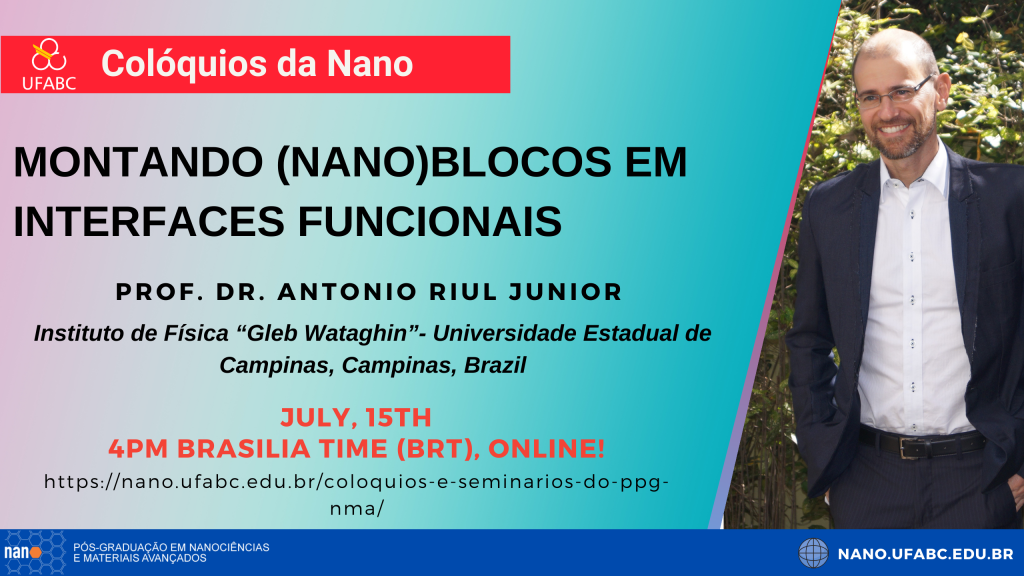
Palestrante: Prof. Dr. Antonio Riul Junior (IFGW/UNICAMP)
Título: Montando (nano)blocos em interfaces funcionais
Data: 15/07 às 16h Link: https://youtu.be/dESknxHeGr4
Resumo: O universo nano permaneceu despercebido até Richard Feynman lançar um primeiro olhar naquela direção, e apesar do progresso imenso nas últimas décadas ainda temos como grande gargalo a organização de nanoestruturas em diferentes escalas. Isto possibilitaria explorarmos propriedades e funcionalidades diversas em inúmeras aplicações, mas como nossa realidade difere bastante das telas de cinemas, infelizmente não conseguimos criar a Mark LXXXV. Temos como barreira primordial o controle adequado na organização de nanoestruturas, e neste sentido falaremos da técnica de automontagem por adsorção física, que a natureza sabiamente explora em diversos fenômenos em diferentes escalas. Brevemente, trata-se da agregação espontânea de diferentes blocos estruturais com controle de espessura em nível molecular, visando recobrimento funcionais de interfaces. Daremos alguns exemplos de aplicação no recobrimento de interfaces. Caso você faça parte do programa da pós entre em contato para participar da webconferência. Carta de Comparecimento: Baixe aqui
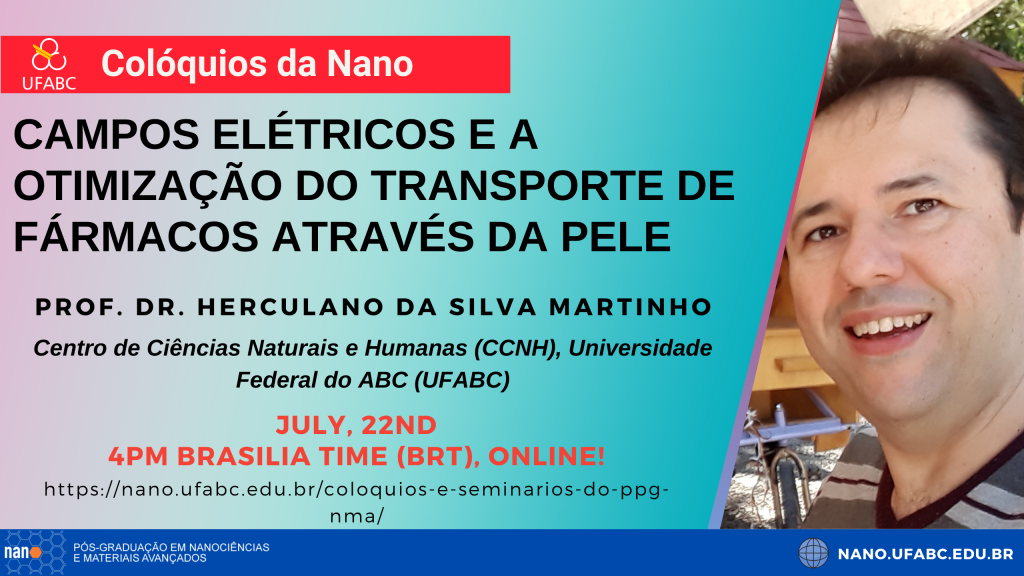
Palestrante: Prof. Dr. Herculano Martinho (CCNH-UFABC)
Título: Campos Elétricos e a Otimização do transporte de Fármacos através da pele
Data: 22/07 às 16h Link: https://youtu.be/fikVGyyEfcE
Resumo: A busca por medicamentos e terapias personalizadas, que minimizem efeitos colaterais, é uma área de pesquisa muito ativa atualmente. Uma das abordagens mais investigadas envolve desenvolver fármacos que possam ser absorvidos pela pele, acessando rapidamente a corrente sanguínea. Há, no entanto, um grande desafio a ser superado: a resistência da própria pele. Neste colóquio iremos apresentar como o emprego de campos elétricos externos pode ajudar a vencer esta barreira. Caso você faça parte do programa da pós entre em contato para participar da webconferência. Carta de comparecimento: Baixe aqui
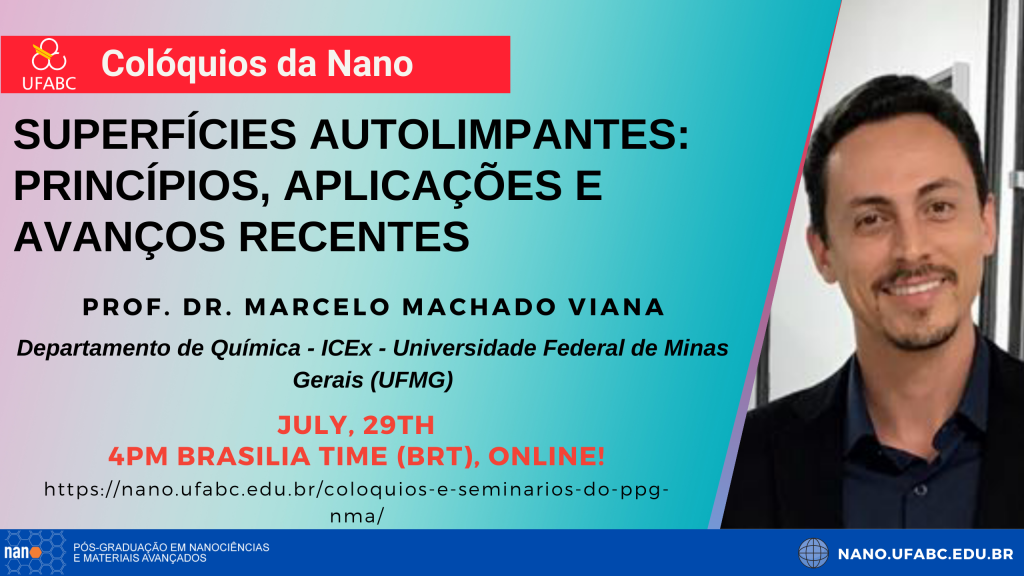
Palestrante: Prof. Dr. Marcelo Viana (ICEx-UFMG)
Título: Superfícies Autolimpantes: Princípios, Aplicações e Avanços Recentes
Data: 29/07 às 16h Link: https://youtu.be/CN5H01wYSvM
Resumo: As superfícies autolimpantes têm despertado grande interesse tecnológico devido às suas atraentes propriedades, possibilitando aplicações em diversas demandas tecnológicas atuais nos setores de energia e meio ambiente. Nesse seminário, serão abordados os princípios básicos envolvidos nos mecanismos de autolimpeza de superfícies, suas aplicações e as principais propostas de modificação desses recobrimentos visando diferentes aplicações. Caso você faça parte do programa da pós entre em contato para participar da webconferência. Carta de comparecimento: Baixe aqui.
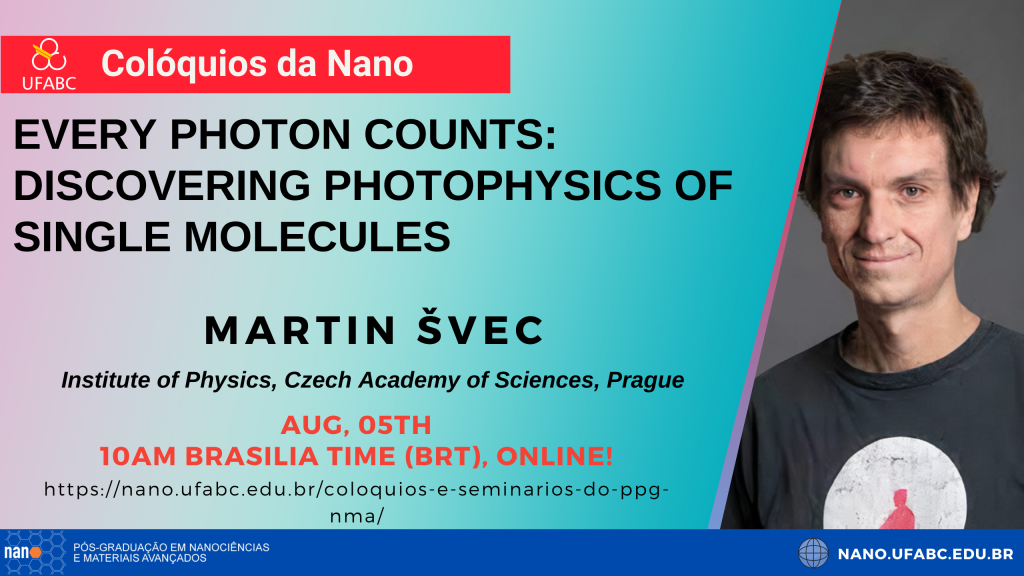
Palestrante: Martin SVEC (Institute of Physics – Czech Academy of Sciences, Prague)
Título: Every photon counts: discovering photophysics of single molecules
Data: 05/08 às 10h Link: https://youtu.be/ZZY0GPhAXqY
Resumo: Exploration of fundamental photophysical phenomena at the level of individual quantum objects requires highly specialized optical spectroscopy with subnanometer, single-photon capabilities. Thanks to recent progress in light microscopy with scanning probes, excited states of molecules and their interaction can now be investigated at the nanoscale with unprecedented detail. Precise injection of charge carriers1 into molecules sufficiently decoupled from the substrates leads to formation of charged states and transient excited states – the excitons. The photons produced by decay events of these states carry information about energies, charges, transient dipoles and temporal evolution of the studied systems. Using an optical path to collect photons from the nanocavity between the tip and sample in a cryogenic scanning probe microscope, we tackle some photophysical phenomena occurring in organic dyes. Carta de comparecimento: acesse aqui
ÚLTIMO COLÓQUIO DO QUADRIMESTRE
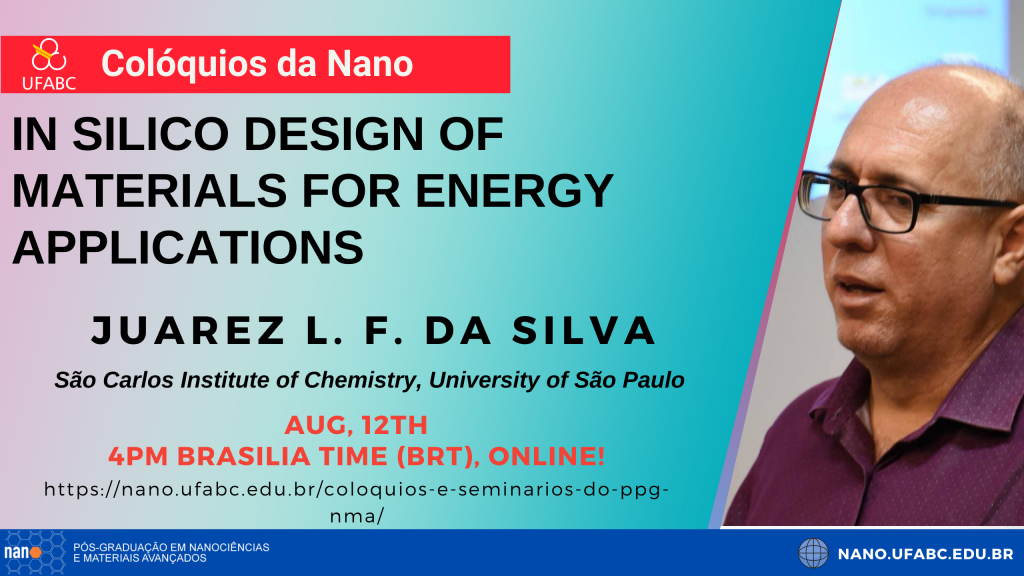
Palestrante: Prof. Dr. Juarez L. F. da Silva (IQSC-USP)
Título: In Silico Design of Materials for energy applications
Data: 12/08 às 16h Link: https://youtu.be/Pa6Mo6IqDwk
Resumo: This talk will summarizes the most important results obtained by the QTNano (Quantum Theory of Nanomaterials) group in the last 3 years, which focus on the applications of computational materials science techniques to design and discovery of materials for energy applications, namely, (1) conversion of CH4 and CO2 into new products using nanocatalysts, (2) perovskites and two-dimensional materials for photovoltaic, (3) and ionic liquids for energy storage. Beyond of that, machine learning and data mining applications will be discussed along the talk. Carta de comparecimento: acesse aqui
RECESSO ACADÊMICO – VOLTAMOS DIA 23 DE SETEMBRO DE 2021

